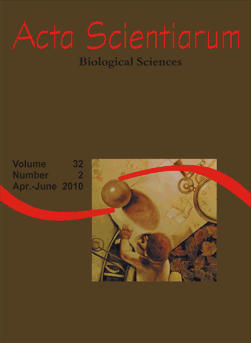<b>Topographic anatomy of the spinal cord and vertebromedullary relationships in <em>Mazama gouazoubira<em> Fisher, 1814 (Artiodactyla; Cervidae)</b> - doi: 10.4025/actascibiolsci.v32i2.5061
Keywords:
brocket deer, neural system, skeletopy, spinal cord
Abstract
To gain an understanding of the detailed anatomical aspects of Mazama gouazoubira (brocket deer), this paper describes the relationships between its spinal cord and the vertebral canal, adding information with a clinical and surgical approach. Three specimens of M. gouazoubira were prepared following the methods normally used in anatomy. The epaxial muscles and vertebral arches were removed to expose the spinal cord and the spinal nerve roots. The dimensions of the medullary segments were measured using a pachymeter with 0.05 mm precision. The spinal cord is cylindroidal, dorsoventrally flattened, with an average craniosacral length of 656.27 mm, and has two dilatations corresponding to the cervical and lumbar intumescences. The cervical, thoracic, lumbar and sacrocaudal segments showed an average length of 175.07, 226.03, 123.47 and 43.63 mm, with indices of 28.02, 35.34, 19.68 and 6.93%, respectively. The medullary cone, whose average length is 46.27 mm, begins between L2 and L3 and ends between S1 and S2, with a mean index of 7.53%. The overall average distance between the nerve roots of the cervical, thoracic and lumbosacral segments was 2.23, 2.06 and 1.98 cm, respectively.Downloads
Download data is not yet available.
Published
2010-05-24
How to Cite
Lima, F. C., Santos, A. L. Q., Lima, B. C., Vieira, L. G., & Hirano, L. Q. L. (2010). <b>Topographic anatomy of the spinal cord and vertebromedullary relationships in <em>Mazama gouazoubira<em> Fisher, 1814 (Artiodactyla; Cervidae)</b> - doi: 10.4025/actascibiolsci.v32i2.5061. Acta Scientiarum. Biological Sciences, 32(2), 189-194. https://doi.org/10.4025/actascibiolsci.v32i2.5061
Issue
Section
Animal Morphology & Physiology
DECLARATION OF ORIGINALITY AND COPYRIGHTS
I Declare that current article is original and has not been submitted for publication, in part or in whole, to any other national or international journal.
The copyrights belong exclusively to the authors. Published content is licensed under Creative Commons Attribution 4.0 (CC BY 4.0) guidelines, which allows sharing (copy and distribution of the material in any medium or format) and adaptation (remix, transform, and build upon the material) for any purpose, even commercially, under the terms of attribution.
Read this link for further information on how to use CC BY 4.0 properly.
0.6
2019CiteScore
31st percentile
Powered by 

0.6
2019CiteScore
31st percentile
Powered by 











1.png)




3.png)













